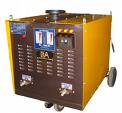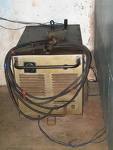Which is better to use for manual arc welding - a transformer or a rectifier
The largest volume among all types of welding is manual arc welding — smooth welding with stick electrodes, in which the feeding of the electrode and the movement of the arc along the welded edges is carried out manually. MMA welding equipment remains the most common group of equipment, including transformers, converters, aggregates and rectifiers. A number of welding current sources are produced, which provide welding with all types of electrodes of various types of steel compounds at currents up to 500 A.
Due to the technological flexibility of manual welding with stick electrodes, the possibility of welding in different spatial positions and the simplicity of the organization of work, these sources are widely used in industry, construction, in assembly conditions and are operated in difficult climatic conditions.
Selection of a welding power source for manual arc welding by type of current
The user is often faced with the question of what type of equipment to use for manual arc welding - a transformer or a rectifier.
 Arc stability. When using a transformer, it is difficult for unskilled welders to keep the arc length constant - quite frequent short circuits occur, as a result of which the arc goes out and the electrode sticks to the workpiece. To some extent, this phenomenon is excluded by the use of electrodes with special coatings that contribute to the stable maintenance of the arc.
Arc stability. When using a transformer, it is difficult for unskilled welders to keep the arc length constant - quite frequent short circuits occur, as a result of which the arc goes out and the electrode sticks to the workpiece. To some extent, this phenomenon is excluded by the use of electrodes with special coatings that contribute to the stable maintenance of the arc.
The main feature of controlled semiconductor rectifiers is the speed of reaction to possible changes in the length of the arc to a short circuit, which makes it possible to drastically increase the stability of arc burning. Therefore, from this point of view, the choice of the rectifier is preferable.
Magnetic blast. In manual welding, the arc may be exposed to a magnetic field, causing it to deflect and reduce the effect on the weld pool. Although this phenomenon can be observed with both alternating and direct current, DC arcs are exposed to it more often. The effect of arc blowout can be reduced or eliminated entirely by changing the position of the return wire clamp or the position of the wire itself relative to the product.
 The quality of the weld. AC welding is much more likely to result in sub-melts, uneven penetration, slag inclusions, ugly beading and porosity. These defects are the result of electrode coating failure due to adhesion, arc length mismatch, and frequent extinguishing.In addition, the complete dependence of the output voltage of the transformer on the change of the supply voltage leads to either insufficient penetration or burnout.
The quality of the weld. AC welding is much more likely to result in sub-melts, uneven penetration, slag inclusions, ugly beading and porosity. These defects are the result of electrode coating failure due to adhesion, arc length mismatch, and frequent extinguishing.In addition, the complete dependence of the output voltage of the transformer on the change of the supply voltage leads to either insufficient penetration or burnout.
The use of a controlled semiconductor rectifier, which, as a rule, has a device for stabilizing the output voltage, significantly reduces these defects. When comparing the price of a transformer and a rectifier, it is necessary to take into account the cost of repair work to correct defects in the welded seam, which depend on the size of the welded product and the number of defective seams.
Reliability and working conditions. All manual welding transformers produced in the country are distinguished by their simple design, lack of control equipment, have natural cooling and are connected to single-phase networks. They can work outdoors. They have very high reliability indicators.
Rectifiers, both without electronic control and with electronic control, are designed for indoor operation, have artificial air cooling and are connected only to three-phase networks. If non-electronically controlled rectifiers are close to transformers in terms of reliability, then the same cannot be said for controlled (electronically controlled) solid state rectifiers. Of course, with increasing reliability of the entire configuration (transistors, thyristors, microcircuits, printed circuit boards, etc.) reliability indicators will grow. But at the moment, according to these indicators, preference should be given to transformers.
 Safety measures.It is known that the threshold value of the damaging electric current for direct current sources is higher than for alternating current sources. In principle, rectifiers with open-circuit voltages up to 100 V do not require voltage limiters, while transformers with open-circuit voltages up to 80 V must be equipped with limiters when operating in particularly hazardous conditions.
Safety measures.It is known that the threshold value of the damaging electric current for direct current sources is higher than for alternating current sources. In principle, rectifiers with open-circuit voltages up to 100 V do not require voltage limiters, while transformers with open-circuit voltages up to 80 V must be equipped with limiters when operating in particularly hazardous conditions.
Transformers with an open circuit voltage of more than 80 V, regardless of operating conditions, must have limiters. The limiter is a rather complex device with a large number of electronic components. The price of a transformer with a limiter is at the level of the price of a rectifier (without electronic control). In addition, the discharger makes it difficult to start the arc and requires a lot of experience of the welder to operate it.
